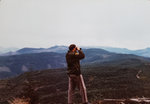
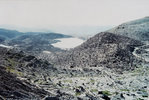
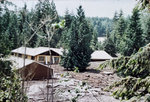
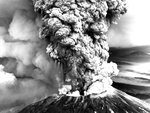
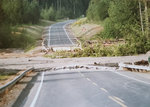

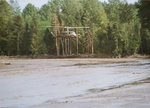

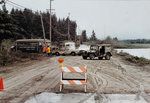
Editor’s Note: May 18 is the 40th anniversary of the eruption of Mount St. Helens. For the first time, Bob Nix, a former deputy with the Cowlitz County Sheriff’s Office, has shared an in-depth account of his memories from that day along with a compelling audio recording of the Cowlitz County radio dispatch in the moments during and after the eruption. That recording is below.
March 27, 1980, Longview, Washington. Four Cowlitz County Sheriff’s Office detectives, including 30-year-old Bob Nix, are walking out of a restaurant after having lunch when they hear a blast in the distance. The detectives don’t know it at the time, but it’s the first of a series of small discharges over the next two months leading up to the eruption of Mount St. Helens.
“We heard this tremendous explosion,” Nix said. “It was a kaboom. We determined later that it was the mountain.”
Thirty-five miles west of Longview, a steam explosion has created a 250-foot wide crater on the mountain, signaling its first eruption in over 100 years. The U.S. Geological Survey has been monitoring Mount St. Helens for 11 days at this point following an initial flurry of 100 small earthquakes that began on March 16. Over the next two days, 105 small eruptions shake the mountain, a warning of something bigger and more dangerous lurking.
Cowlitz County Sheriff Les Nelson assigns Nix to work the Toutle Lake area as a liaison between the sheriff’s office and Dwight Crandell, a scientist with the USGS. Washington state had already created a comprehensive plan to evacuate towns nearest to the mountain in the Toutle River Valley, an area located nine miles southeast of Toledo. It encompasses Kid Valley, Maple Flats, 12 Road Camp, Camp Baker, 19 Road, Toutle proper and Silver Lake. The area contains about 3,000 residents at the time, with clusters of homes along the north fork of the Toutle River.
The plan involved having Sheriff Nelson called first in the event of a major eruption, then Skamania’s sheriff, the undersheriff, deputies and so on. Nix was about 20 people down the call list.
Crandell tells Nix that anyone within the Toutle River Valley would have a tight window to evacuate safely. Looking at the state’s comprehensive plan, Nix knew there wouldn’t be enough time to notify all the residents.
“(Crandell) said, ‘If you don’t get these people out in 20 minutes, then pyroclastic flow could kill everybody,’” Nix said. “So what do I do? I see a plan here that isn’t going to work.”
Forty years later, Nix sat down with The Chronicle to recount his experiences leading up to and immediately after the eruption of Mount St. Helens, the deadliest volcanic eruption in United States history and event that put Southwest Washington on a national stage.
Thursday, May 15, Toutle, Washington
Four days before the eruption, Nix attends the Cowlitz County Fire District 3 meeting in Toutle. He brings copies of the comprehensive plan and shows them to firefighters, first responders and aid units, explaining the faults in it.
“Everybody agreed, this is not going to fly,” Nix said.
Nix comes up with another plan. All the police cruisers, fire trucks and ambulances have the same three siren systems: a yelp, which is the most common one heard today; a siren wail; and lastly a European-style siren that goes: ‘dee da, dee da, dee da.’
No police or emergency units used the European-style at the time, so Nix instructs everyone at the meeting to go door-to-door that night, every house from Maple Flats and Toutle to Silver Lake, telling people that if they hear the ‘dee da, dee da’ sirens that it means the mountain has exploded and it’s time to evacuate.
“So we had a plan,” Nix said. “We had our own plan. I was going against the state comprehensive plan. You just don’t do that. But in good conscience I didn’t think I could do anything else. It may cost me my career, but we have to do it this way.”
Present day, Chehalis, Washington
Forty years later, on Nix’s 440-acre farm, he regrets nothing of his decision. Toutle residents had been worried about what was going to happen to them for the two months leading up to the explosion.
“When we put that plan together they felt like at least they had a plan,” Nix said.
Saturday afternoon, May 17, 1980.
It’s been a month and a half since the initial eruption. Washington state Gov. Dixie Lee Ray signs a proclamation to allow property owners who have been blocked from the red zone near Spirit Lake to return and gather items from their cabins.
There was only one resident who was still actively living in the red zone at that time, Harry R. Truman, owner of Mount St. Helens Lodge on Spirit Lake, who became a media sensation and folk hero for holding out.
The 50 other property owners sign release waivers at the nearest roadblock to Spirit Lake. They are led by a police escort that includes Nix and Skamania County Sheriff’s Office deputy George Barker. Nix and Barker also have the residents fill out missing persons reports for anyone who doesn’t sign out on their way back through the checkpoint.
When they arrive at the mountain an eerie silence fills the forest. Nix remembers it well. No birds chirping, no squirrels scurrying up Douglas fir, no deer or elk grazing. Nix looks up at the mountain and can’t see the peak because of the gigantic bulge on the northern side that has been growing at a rate of five feet per day for the last 10 days.
“I was nervous,” Nix said. “I didn’t think those people should be up there.”
Nix and Barker talk to Harry Truman one last time.
“Harry Truman looked at me like he wanted me to just hit him over the head and put him in the back of the car,” Nix said. “He was nervous, but damned if he was going. I had no choice other than kidnap him, which I wasn’t going to do.”
Nix was one of the last people to see Truman alive.
That night, the property owners plead to Gov. Ray, asking if they can go back the next morning to pick up the rest of their belongings. Ray signs another proclamation and Nix is set to meet them the next morning and leave Toutle Lake High School at 8 a.m.
6:30 a.m., Sunday, May 18, Toutle, Washington
Nix receives a call from one of the property owners who explains they need to go buy a new battery because their truck won’t start. They ask to reschedule to leave at 10 a.m. Nix agrees.
So Nix drives 20 miles to the Cowlitz County Sheriff’s Office in Kelso to turn in some paperwork. He arrives as a squad meeting is going on. He begins to not feel well. Nix isn’t one to believe in the supernatural, but he had this gut feeling that something is wrong. So he leaves the office and heads back north up Route 411 toward Toutle, which runs parallel to Interstate 5.
8:30 a.m., May 18, Vancouver, Washington
USGS research geologist Don Swanson, a Centralia native, is stationed at Gifford Pinchot National Forest office in Vancouver, Washington.
Swanson has been monitoring the mountain since its first small eruption on March 16. He is waiting on a shipment of supplies before he heads to Coldwater II camp, an observation post near the mountain where colleague David Johnston had camped the previous night.
8:32 a.m., May 18, Mount St. Helens
A magnitude 5.1 earthquake rattles the mountain as the northern bulge rips away from the volcano, creating the largest debris avalanche ever recorded. It travels north and then west down the north fork of the Toutle River.
Thunderous eruptions burst laterally, overtaking the debris landslide at 300 miles per hour and scorching 230 square miles of forest. Within 15 minutes, ash, gases and smoke have risen 15 miles in the air. Pyroclastic flows pour out of the crater at 50 to 80 miles per hour. The wind eventually carries millions of tons of ash east, turning day into night in some parts of eastern Washington.
Swanson is waiting in the seismograph room in Vancouver when he and a colleague see the seismograph needles begin jumping.
“I ran to the radios and tried to contact David and couldn’t, so I knew something big had happened,” Swanson said.
Johnston had radioed a message to the USGS headquarters in Menlo Park, California: "Vancouver, Vancouver, this is it!"
He was never heard from again.
8:33 a.m., March 18, Kelso, Washington
Sheriff Nelson is the first to call the Cowlitz County 911 Dispatch. He tells dispatch his chandeliers are swinging at his home on 30th Avenue and Ocean Beach Highway in Longview, and he can see the biggest cloud of smoke he’s ever seen coming from the mountain.
Dispatch soon begins receiving calls of people describing a giant cloud of black smoke, asking if the mountain has exploded. Before long, they’re overwhelmed with callers.
At this time, Nix is in his squad car still heading north on Route 411 and begins to hear radio chatter of a possible eruption. He reaches Route 504 East and guns his car to speeds of 90 miles per hour toward Toutle. His wife and kids are there at the family home and he knows the town needs to evacuate immediately.
First, he drove to his house and told his wife to go to his father’s farm in Chehalis.
“So they drove (to Chehalis) and stayed with my mother for a couple days because we were too close,” he said.
Nix soon arrives in Toutle while ambulances and fire trucks begin to block the right lane of Route 504 leading closer to the mountain, only letting traffic out. Nix begins canvassing roads with his high-low siren alerting townsfolk to the eruption.
“We got everybody out of there in 20 minutes,” Nix said. “It was absolutely spectacular the way those people took it seriously. They were calm and orderly and I couldn’t have been prouder of those people.”
9 a.m., Mount St. Helens
Swanson and the forest service pilot arrive near the mountain in the air. They can’t get around to the north side where most of the destruction took place, so they circle back and forth around the south side and watch lightning storms flicker around the mountain as a gigantic ash plume rises up.
“It was kind of an eerie sensation because all this energy was being released but we couldn’t hear anything,” Swanson said. “It was almost like being at a silent movie … I had never seen any explosion of that size anywhere else, and I haven’t since then.”
10 a.m., Two Miles West of Toutle, Washington
Nix arrives at the intersection of George Taylor Road and Route 504. Officers have set up a command post with Tri-county Search and Rescue’s old green school bus. They don’t know it yet, but the first lahar (volcanic mudflow) is barreling down the north fork of the Toutle River.
It is now about an hour after Toutle has been evacuated and the Cowlitz County undersheriff, who Nix will not name, instructs Nix to start the evacuation procedure for the Toutle River Valley.
“I said, ‘There’s nobody in Toutle,” Nix said. “We got everybody out. He was not real happy I had gone around the comprehensive plan.”
The undersheriff spent the next year attempting to bring Nix up on insubordination charges.
Soon after, Nix spots a Bell Telephone Company truck heading out the blockade to evacuate and he stops the driver. Nix orders the driver to climb a nearby pole and hook up a telephone to the search and rescue bus. There are no cellphones, no laptops in 1980. The driver, visibly shaken from the eruption, complies.
“I don’t know who’s phone number it was, who he assigned the bill to, but he climbed that pole and got us a phone,” Nix said. “Then he climbed down, ran to his truck and took off. I don’t even know his name. But there's a guy somewhere telling that story to his grandkids.”
Not long after, helicopter pilots radio the command post telling them a 100-foot-tall wall of debris is careening toward them down the Toutle River. Everyone other than Nix and Sgt. Doug Mayfield retreat back to Interstate 5. Nix and Mayfield look over at a nearby hill and ask each other if they think it’s 100 feet tall. They both agree it isn’t.
“He says, ‘You go on back to I-5, because you’ve got kids,’” Nix said. “I says, ‘We’re doing this together. Ain’t no way I’m leaving you up here.”
10:30 a.m., two miles east of Toutle
The first lahar reaches the north fork of the Toutle River a half-mile west of Toutle where Nix and Mayfield are parked.They aren’t prepared for what they spot coming down the river.
“I saw road graders, log trucks, houses, chunks of ice and logs on fire go down that river,” Nix said. “That was absolutely mind-blowing.”
Three billion cubic yards of material is deposited in the upper 17 miles of the north fork Toutle River valley. It eventually reaches the Cowlitz River where it drains into the Columbia River.
The aftermath
When all is said and done, 27 bridges and 200 homes have been demolished and 31 ships in the Columbia River are at a standstill.
In all, Fifty-seven people died, making Mount St. Helens the most deadly volcanic eruption in North American history. Nix would receive an award from the Cowlitz County Sheriff’s Office two years later on March 20, 1982, for his efforts in helping evacuate the Toutle River Valley.
He recalls when the Spirit Lake property owner called him the morning of the explosion to reschedule the time to head to the lake from 8 a.m. to 10 a.m. A call that likely saved his and the other property-owners’ lives.
“If it hadn't been for that battery,” Nix said. “It takes a half hour to get to the mountain. We would have been right there when it blew up.”
Years later, Nix would check his police notebook, a log of his police activities, during the time of the eruption. It was one of the most important times of his 10-year law enforcement career. There was only one entry during a two-week period: “Kelso north, 8:28 a.m.”
Nix can still remember the day vividly, four decades later. He still dreams about that day. The good and the bad.
“When you have been through something life-threatening it changes ya,” Nix said. “I remember it like it was yesterday, and it’s been 40 years, because it was well embedded into my brain.”
Echoes of an Eruption: Former Deputy Shares Dispatch Recording, Experiences of May 18, 1980